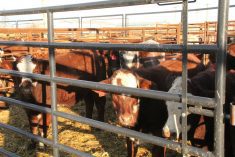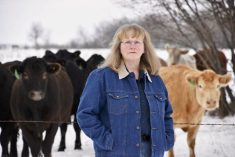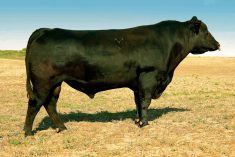– Rick Wright,Heartland Order Buying Co.
“There will be more competition from the U. S. for Canadian cattle this fall.”
The outlook for the Manitoba cattle industry includes reduced cattle movement, aggressive U. S. buyers, a possibility of lower feed prices, later deliveries, an increase in demand for yearling cattle, and steady cow prices.
During the week ended July 9, cattle movement was said to be slow, according to auction summaries, as the industry is in the middle of its summer shutdown.
Read Also

Pig transport stress costs pork sector
Popular livestock trailer designs also increase pig stress during transportation, hitting at meat quality, animal welfare and farm profit, Agriculture and Agri-Food Canada researcher says
The number of head is expected to decrease come fall, according to Rick Wright, a cattle buyer with Heartland Order Buying Co. Cattle movement will decline, he said, because of the liquidation of cattle which has been occurring since last fall. The decline will be caused by producers holding on to heifers for breeding purposes and an overall lower supply of yearling cattle, he added.
“More yearlings will be held back for retained ownership or are already committed to forward contracts, so that’s going to reduce the numbers,” said Wright.
Supply and demand will play a factor in cattle prices come fall, Wright said, but the value of the Canadian dollar will be a key factor.
According to Wright, the Canadian currency is expected to trade lower versus the U. S. greenback. A lower-valued Canadian dollar will mean more aggressive American buyers compared to last year.
“There will be more competition from the U. S. for Canadian cattle this fall,” said Wright.
The availability of feed is expected to increase, according to Wright. Wet weather conditions through the Canadian grain belt are expected to affect the production quality of some crops, but no official estimates have been made. If the crop quality is lower, Wright said it will make its way into the feed sector.
Also, he said, a strong U. S. corn crop is expected, which means cheap feed. However, the amount of feed shipped in from the U. S. will depend on the status of the Canadian currency.
“If the Canadian dollar is at 90 cents and not at par, it’s more difficult for us to bring in corn from the U. S.,” explained Wright.
Come fall, the Manitoba cattle industry might see later deliveries due to pasture conditions. Currently, they are saturated and there is a lot of bug activity, according to Wright. However, if the fall brings more favourable weather and the province experiences a late fall, similar to last year, it will mean cattle staying on pasture for a longer period of time.
Wright also expects there will be an increase in demand for yearling cattle from U. S. buyers, which will mean competition for Canadian feedlots.
“We could see Canadian feedlots be more aggressive on calf prices than they were last fall, just in an effort to have inventory ready to sell in January, February and March,” he said.
He also expects the price of finished cattle will increase while the price of cows will remain steady.
Demand for hamburger is “extremely strong,” said Wright.
An increase in demand for hamburger meat in the summer is typical, as barbecue season is in full swing.
“The dollar menus in the U. S. (fast-food restaurants) have really prompted high hamburger sales and that’s really helped the cow prices stay steady,” said Wright.
FROM THE AUCTION FLOORS
Note: All prices in Canadian dollars per hundredweight (cwt). These prices also generally represent the top one-third of sales reported by the auction yard.
Ashern Livestock Mart: Closed until mid-August.
Gladstone Auction Mart: Too few cattle were marketed this week for a report. The last auction for the summer will be July 13 and Gladstone will open again on Aug. 16.
Grunthal Livestock Auction Mart: Closed this week. The next sale will be held July 14; auctions will be held every other week in July and August.
Heartland Livestock Services, Brandon: A total of 158 cattle were on offer in Brandon during the week.
A1-A2 steers traded from $78 to $81.50; A1-A2 heifers, $75-$79.50; D1-D2 cows, $52-$59, age verified $57-$60.75; feeder cows, $45-$52; shells, $30-$44; and good bulls, $68-$72.25.
Feeder steers weighing 900-1,000 lbs. sold from $85 to $96; 800-900 lbs., $95-$101; 600-700 lbs., $100-$106; 500-600 lbs., $100-$108; and 400-500 lbs., $105-$118.
Feeder hei fers weighing 900-1,000 lbs. sold from $82 to $88.25; 800-900 lbs., $85-$94.25; 700-800 lbs., $90-$98; 600-700 lbs., $92-$109.50; 500-600 lbs., $100-$116.50; and 400-500 lbs., $100-$115.
Auctions will be held every Tuesday during the summer.
Heartland Livestock Services, Virden: A report was not available this week. Auctions will be held every Wednesday at Virden during the summer.
Killarney Auction Mart: Now closed until mid-August.
Pipestone Livestock Sales: Closed until the end of August.
Ste. Rose Auction Mart: The next sale will be held Aug. 12.
Taylor Auctions, Melita: The next sale will be held Aug. 19.
Winnipeg Livestock Sales: There were about 395 head of cattle sold during the week ending July 9.
In the slaughter market, choice steers and heifers sold from $82 to $86; select steers and heifers, $78-$82; dry fed cows, $48-$52; good fleshed, $45-$48; lean, $38-$35; young age verified, $48-$63; and good bulls $65-$74.
Feeder steers weighing 800-900 lbs. brought $90-$97; 700-800 lbs., $95-$105; 600-700 lbs., $100-$112; and 500-600 lbs., $105-$119. Feeder heifers weighing 800-900 lbs. sold from $85 to $93; 700-800 lbs., $85-$94; and 500-600 lbs., $95-$108.
Winnipeg will hold sales on Fridays only during the summer.
Amanda Lefley writes for Resource News International
(RNI), a Winnipeg company specializing in grain and
commodity market reporting.


















